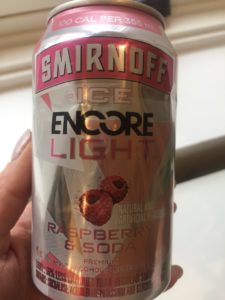My 14-year-old daughter stopped at the dep on her way home from school last week, looking for a snack after a lengthy extra-curricular activity. The depanneur (convenience store) is right next to the school and very familiar with the teen students in their plaid kilt uniforms.
She bought a can of low-calorie raspberry soda and hopped on the bus home. But the soda tasted strange. Way too sweet. So she checked the ingredient list and was shocked to find it contained 4% alcohol.
“Um, Mom? I bought alcohol by mistake.”
Turns out what she actually bought was a Smirnoff cooler with a raspberry & soda flavour. The Smirnoff label is very prominent but like the average 14-year-old, she didn’t know or recognize the brand name. Everything else about the packaging (see photo) suggests this was a soft drink.
Initially, we laughed off her error and poured it down the sink. I told her how glad I was that she told me about it. She wasn’t at fault and certainly wasn’t in trouble.
Then I got upset. And the more I thought about it, the angrier I got. But not with her.
First of all, I was upset that the dep employee sold alcohol to a 14-year-old wearing the familiar high school uniform (she even had on a hoodie with the school name). She wasn’t challenged or asked for identification. Moreover, the product wasn’t in a beer and cooler fridge, surrounded by other products obviously containing alcohol; it was in a six-pack on a shelf next to some bananas and snack foods.
Mostly, however, I was upset about the packaging for this product. It’s easy to see how a teenager unfamiliar with the Smirnoff brand might think it’s a soda. The most obvious marketing messages in this packaging design are about the low calorie nature of the beverage and the raspberry soda flavour. Even if a young person was deliberately seeking alcohol, it makes it seem so benign. And the sugary sweet taste promoted by the beverage suggests it’s designed for young drinkers.
The whole mixup seems particularly onerous in the wake of the death from alcohol poisoning last month of another 14-year-old girl from Laval. Athena Gervais had reportedly been drinking a high sugar alcoholic beverage called FCKD UP purchased from a nearby depanneur. Laval-based Groupe Geloso, which manufactured the drink, announced soon after that it was stopping production and pulling it from shelves. Similar to the American beverage, Four Loko, the drinks are very high in alcohol and caffeine – and both brands appeal to youth.
It seems the problem is bigger than just those one or two particular drinks. Can we address the way packaging and marketing specifically appeals to underage drinkers? How it is deliberately promoted to seem like candy or energy drinks or soda as if it were completely safe for all?
The day after this incident, I went over t0 the depanneur where my daughter bought this drink. Full of mama rage, I confronted the owner. To his credit, he was shocked and horrified and apologized immediately. He recognized that placing these drinks next to snack foods and away from the rest of the alcohol could be confusing to students and pledged to move them right away. And he promised to reinforce to all his employees that the legal age for alcohol consumption in Quebec is 18, and they must demand identification to prove their age. My 14-year-old could easily pass for older, but she was wearing a high school uniform and thus clearly no older than 17. She claims the worker showed zero interest in what she was purchasing.
I was satisfied with the owner’s response and proud of my daughter for speaking up. But I remain concerned about this kind of misleading advertising. There are many reasons why alcohol consumption can be dangerous for teens, from alcohol poisoning to addiction, heightened risk of assault, drinking and driving, and decreased judgment. This kind of marketing is unethical and it’s our kids who pay the price.


